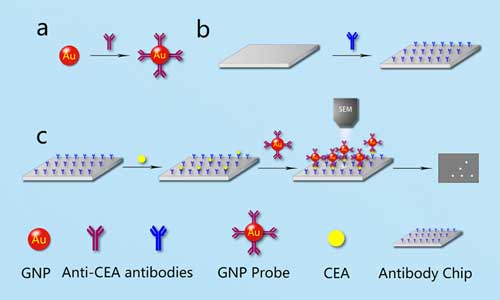| Apr 19, 2019 | |
Counting antigens with gold nanoparticles(Nanowerk News) Protein biomarkers provide valuable diagnostic and prognostic information relevant to the development of malignant diseases since early and accurate detection of cancer is critical for successful cancer therapies. |
|
| In most cases, a tissue biopsy is the initial means of making a diagnosis after some form of cancer screening has come up with a positive result. However, tumor antigen-specific autoantibodies – antibodies produced by the immune system that are directed against one or more of the individual's own proteins – are known to appear months even years before clinical diagnosis of cancer, and autoantibodies have been found in many types of cancer. | |
| There are two mainstream protein assays routinely used in the clinical environment, namely enzyme-linked immuno-sorbent assay (ELISA) for soluble markers and immunohistochemistry (IHC) for tissue samples. ELISA is widely used due to its simplicity but is only capable of quantifying relative amounts of target proteins. | |
| On the other hand, IHC plays an important role in determining the expression of specific antigens in pathological examination of tissue sections, which provides important insight about the malignant degree of the tumor but no digital information about expression levels. | |
| With increasing accuracy, nanosensor platforms for detecting cancer biomarkers are becoming viable complements to invasive biopsies of metastatic tumors (see for example: "A quick and simple blood test to detect early-stage cancer"). | |
| In recent work, reported in ACS Applied Materials & Interfaces ("Gold Nanoparticle Probe-Assisted Antigen-Counting Chip Using SEM"), researchers in China propose a gold nanoparticle (GNP) probe-assisted sandwich-counting strategy in vitro that relies on a GNP probe, an antibody-functionalized chip to 'count' antigen molecules using a scanning electron microscope. | |
 |
|
| (a) GNP probe preparation. (b) Functionalization of the chip with antibodies. (c) Procedures for counting the antigen molecules using GNP probe-assisted SEM-counting chip. (Reprinted with permission by American Chemical Society) | |
| As illustrated in the image above, the team's strategy includes three steps and relies on: 1) functionalized GNPs; 2) antibody modified silicon chips, which are prepared by standard chemical modification; and 3) SEM for the quantification step. | |
| In their work, the scientists used the carcinoembryonic antigen, which is highly expressed in tissue samples of colorectal cancer patients and is the preferred prognostic biomarker, as a model protein biomarker to validate the proposed GNP probe-assisted counting chip. | |
| Furthermore, the strategy was employed to count another cancer-associated protein marker, α-fetoprotein in the interfering protein condition, demonstrating the clinical applicability of this novel platform. |
 By
Michael
Berger
– Michael is author of three books by the Royal Society of Chemistry:
Nano-Society: Pushing the Boundaries of Technology,
Nanotechnology: The Future is Tiny, and
Nanoengineering: The Skills and Tools Making Technology Invisible
Copyright ©
Nanowerk LLC
By
Michael
Berger
– Michael is author of three books by the Royal Society of Chemistry:
Nano-Society: Pushing the Boundaries of Technology,
Nanotechnology: The Future is Tiny, and
Nanoengineering: The Skills and Tools Making Technology Invisible
Copyright ©
Nanowerk LLC
|
|
|
Subscribe to a free copy of one of our daily Nanowerk Newsletter Email Digests with a compilation of all of the day's news. |
